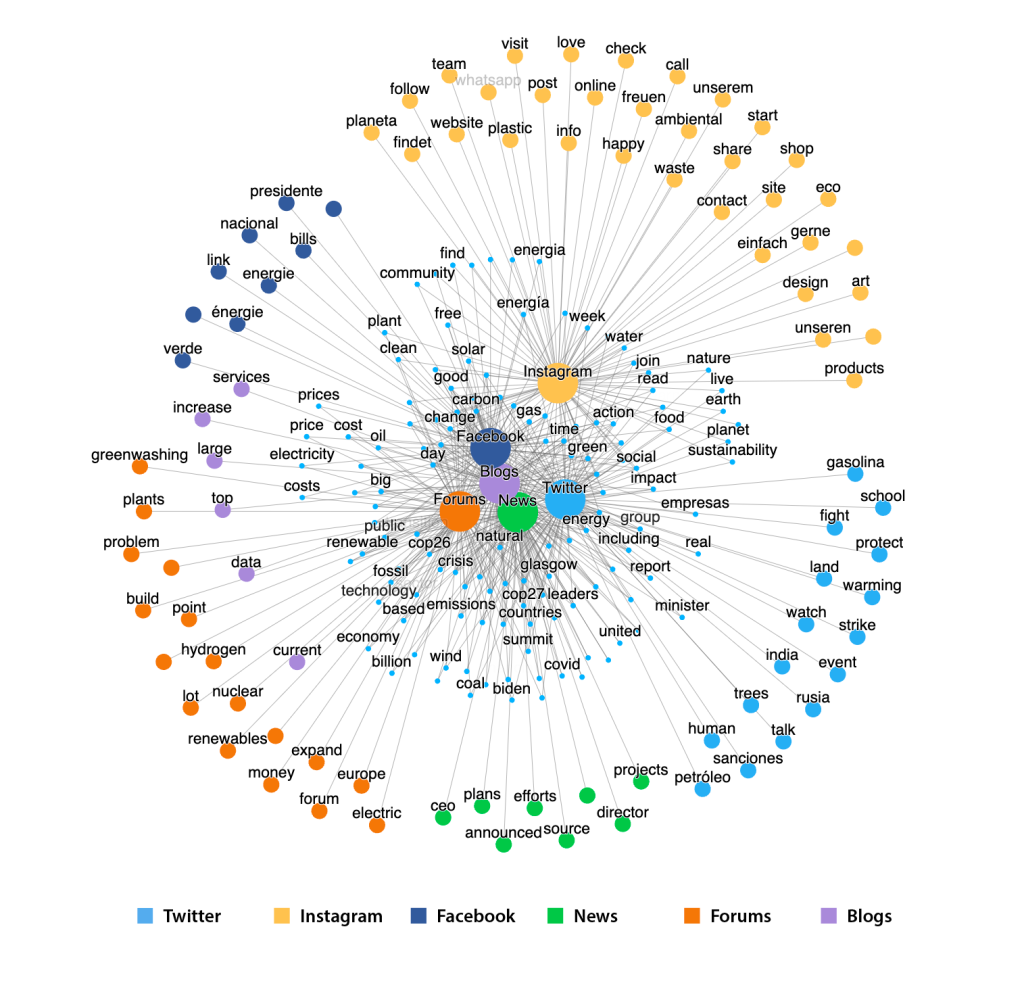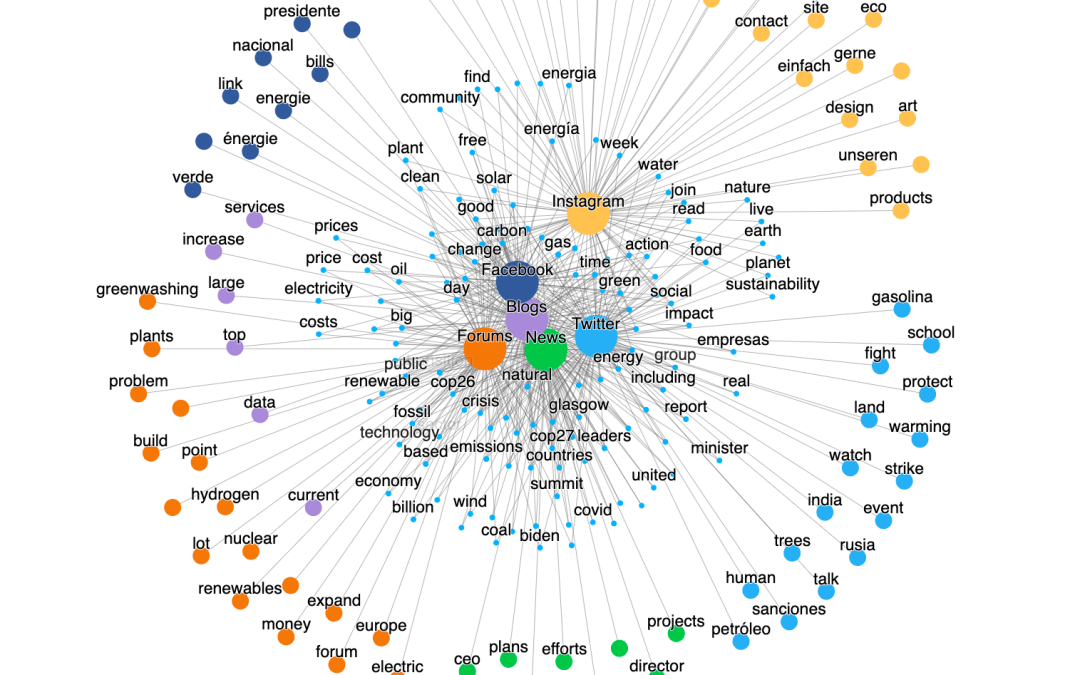With this second part we conclude the interpretive examination we had set out to do.
In the previous section, the analysis focused on “what” was communicated/discussed online about sustainability within the 41,505,000 different contents related to discussions that emerged during the preparatory and post-event periods of COP26 and COP27 on environmental and climate change issues, from October 1, 2021, to April 7, 2023. This time, the focus turns to the “how” and, more precisely, the intent is to verify – through the platform employed for web and social media listening – whether there is a possible media and/or language concentration among the content transferred to the observed media and social channels.
The evidence is needed, considering that social media (Kaplan, Heinlein, 2010) are “a group” of applications built on the ideological and technological principles of Web 2.0, allowing for the creation and exchange of user-generated content composed of images, text, audio files, video, or a mix of these (such as blogs, microblogs like Twitter, social networking sites like Facebook, YouTube, Instagram, WhatsApp, etc.) and represent the “enabling” means to social networking (network of people, as a social structure united by interests of various kinds).
Therefore, it is easy to understand how each social media – in addition to facilitating social networking among people interested in sustainability issues – presents specific audiences, targets, as well as codes, languages, tone of voice and content that require continuous harmonization but not homogenization. Moreover, we do not consider – for what is relevant here – that there are further differences related to multimedia (composed, precisely, of images, texts, audio files, videos, etc.) or monomedial (less and less recurrent!) content systems and representations.
Thus, the goal was to investigate whether there are particular “slices of bread” (channels, media, social media, platforms) on which what we metaphorically defined as “sustainability’s-jam” is spread and whether the latter (related to the totality of linguistic data, extracted contents related to sustainability) is differently spread (specific use of words and text for each social channel), more frequently, less frequently, or in absolutely similar ways across platforms.
A brief premise
The communication of sustainability cannot escape the rapid digital evolution and transformation that is expressed in new channels, new media, new forms of expression, new languages and communicative styles or tone of voice, as it modifies and propels the way of representing reality and therefore also the way of expressing oneself. This is why the analysis focused precisely on social media that have greatly transformed the use of grammar and language of communication, in general, and whose specificity is captured for sustainability communication.
Despite the increasing use and impact of digital media and sustainability content within them (see previous piece), it is evident how they create “a new environment by incorporating previous ones” (McLuhan 1967: 9) and becoming both physical and perceptual extensions of humans. In fact, the perceptual and emotional constructs that communication is able to activate are realized because the media and their content-messages)-“enter inside us” and creep through perceptual sensors-eyes, ears, smell, taste and touch-to reach the head and heart. Therefore, observing how language is employed in social media allows us to understand/hypothesize the processing that the brain performs by “transforming” written language (in our case) into ideas and concepts related to what is transferred/exchanged online.
First evidence: What languages are used on social media to communicate sustainability?
In recent years, with the increasingly rapid development and spread of social media and global communication, the Italian language and, in general, all languages have also undergone changes. Italian could express different concepts with terms integrally in our language, but on the Internet this has not happened because using anglicisms and/or deriving verbs directly from them is a faster, quicker and more socializing way. As a matter of fact, large communities of people interact daily on the platforms that, even just through “sharing,” foster the mutation of language, an ever-living organism!

In addition to acronyms, abbreviations and emoji, English terminology occupies a prominent position on the Web. For most social networks – of English or American origin – the terminology used is necessarily anglophone. In Italy, some English words are now in daily use: googling (verb to google!), downloading, tagging, linking, posting, chatting, tweeting, instagramming, and many others; this is making the language “liquid,” as well as formed by abbreviations, acronyms such as like, post, stories. Therefore, new words, introduced and used especially (but not only!) by young people, precisely because the “language of socials” has tangencies with the so-called “language of young people,” as well as of those who want to feel young!
Therefore, it will be no coincidence that English is found among the most widely used languages for communicating sustainability; Italian compared to total content ranks sixth!
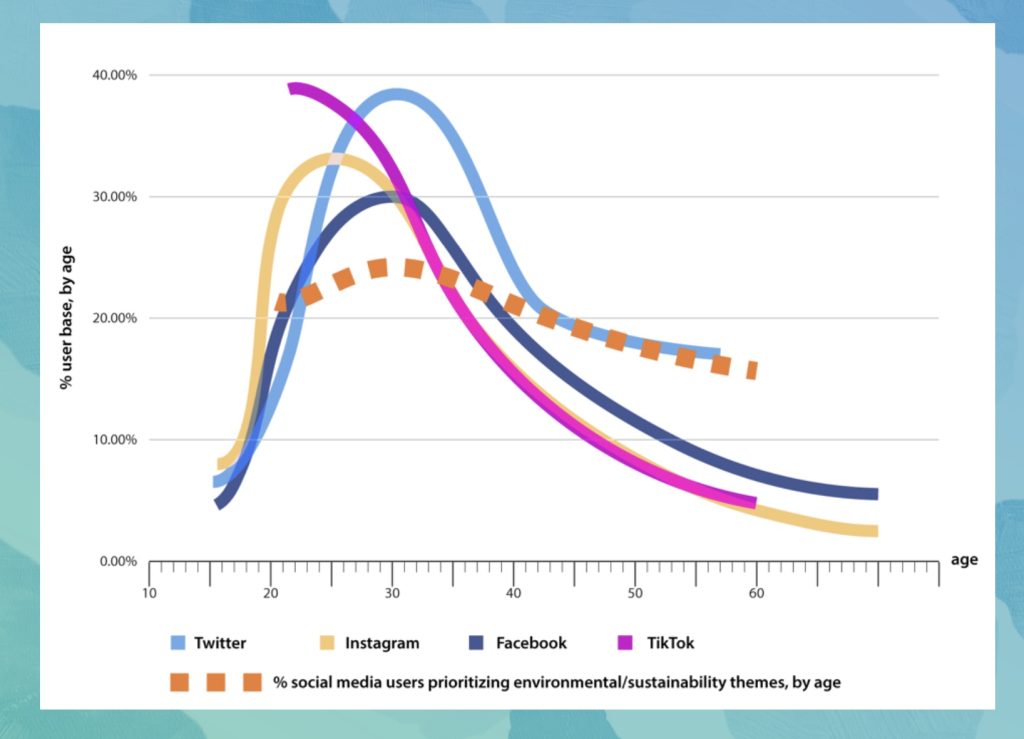
Second evidence: what social media for social networking on sustainability?
One question we tried to answer was, “In communicating sustainability on social media, are there means that enable social networking of specific target audiences?”
A possible answer can be obtained by looking at, on the one hand, the demographic trend of users of social platforms (Datareportal/GWI data) and, on the other hand, whether there are age groups of social users for whom environmental sustainability or sustainability-related issues in general are a priority. The proxy employed, with the help of GWI data, was the (positive) rating towards “sustainable” brands (Global Web Index), as a potential indicator of users’ “positive predisposition” to listen and, even more, “converse” about such topics.
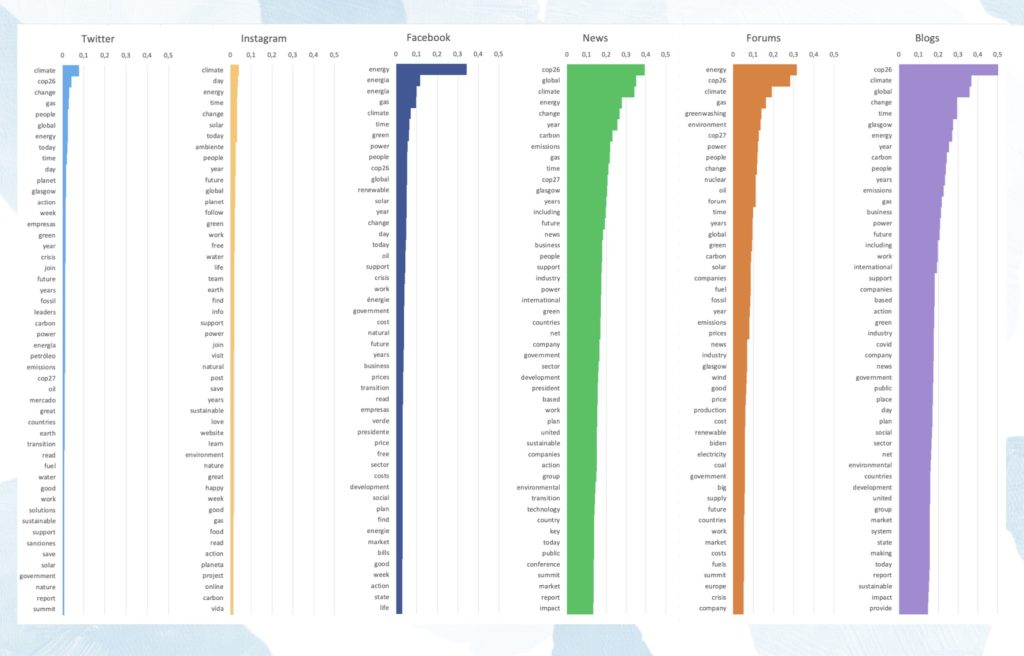
In line with numerous existing analyses of social media, it is shown that Twitter and Facebook primarily reach the 25-40 age group, while TikTok and Instagram are the social media with the highest concentration of use by the youngest (under 25).
The age group that prioritizes sustainability when evaluating brands and, consequently, shows a “positive predisposition” to this topic ranges from 27 to 40-year-olds (cohort 27-40 years old).
Therefore, while Twitter and Facebook turn out to be the most suitable and most akin social networks for “talking” and “communicating” sustainability to the age groups most receptive and sensitive to environmental issues, much, hopefully, could be developed to reach younger targets, currently less involved with sustainability, by taking advantage of the distribution of content on TikTok and Instagram (social media most used by young people).
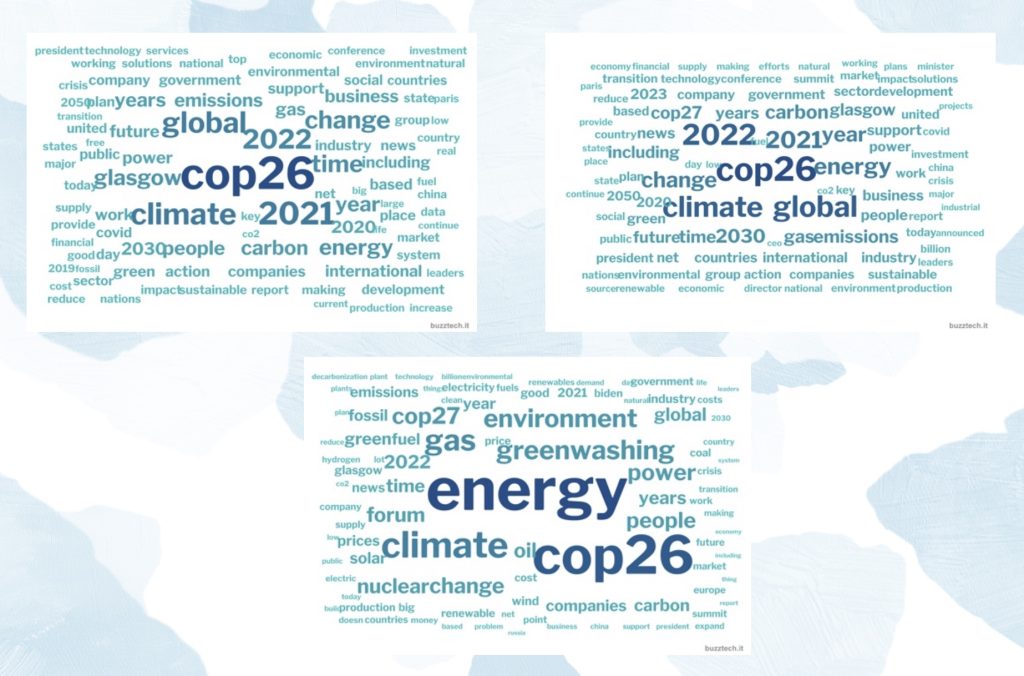
Third and Fourth (and final) evidences: what are the terms most used by social media for sustainability communication? are there terms of exclusive use of a specific social media for sustainability communication?
In line with what was previously highlighted, a question we tried to answer was, “…but in the communication of sustainability on social media, is there a convergence, a concentration of terms/content?”
For blogs, forums and news where, by the very nature of the media, there is a greater reliance on written texts, the density of terms is certainly significant, especially when compared with Facebook, Instagram and Twitter.
For the three types of social media enjoyed by a more adult audience – blogs, forums and news – the following can be highlighted.
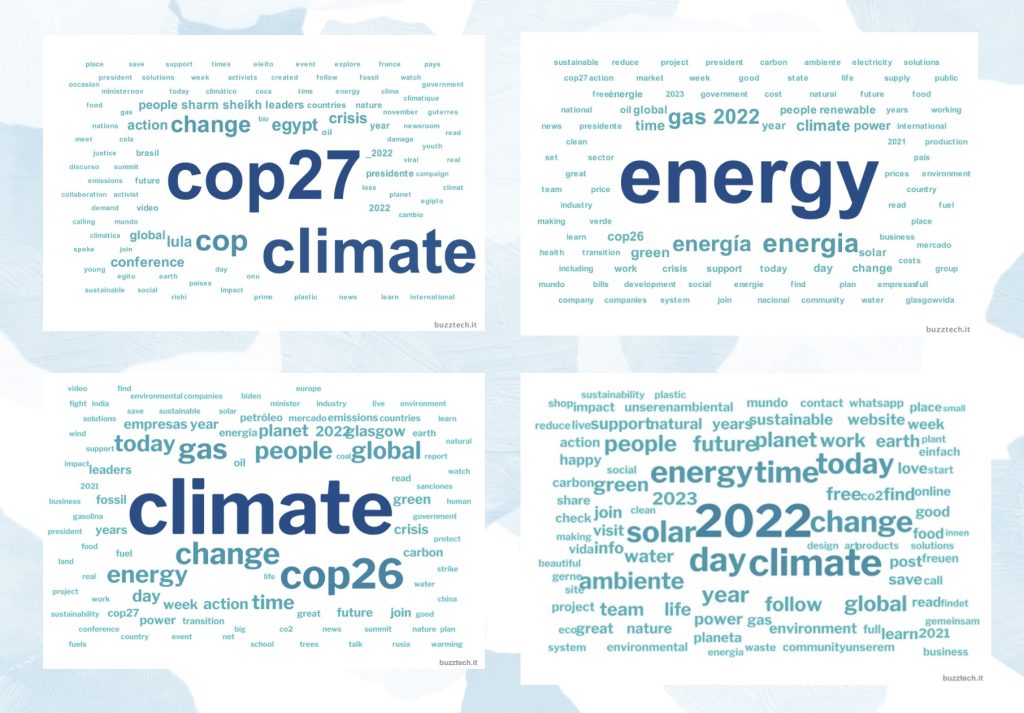
In the case of blogs, it can be observed how, beyond COP26 – which assumes a central and relevant role among the different contents – the terms are many (almost too many and excessive), diverse and, in some ways, generic, with low recurrences; the use of blogs , now widespread as a medium-owner by numerous companies/institutions (for products, brands, events, etc.) could justify the multitude of references and terms. Similarly to blogs, for news, in addition to the abundance of content, the different time frames seem to be relevant: past (2021 and 2022), present (COP26), and future, expressed through terms such as year, time, and future. Other words, though usual and generic such as global and climate, accompany the temporal dimension. As far as forums are concerned, the idea of “discussion” or being able to “chat” more or less freely within them seems to reward both the incisiveness and recurrence of the discussed topics (energy, cop26, climate) but, above all, it appears to be the only medium on which explicit use is made of the term “greenwashing” that assumes the same relevance as content related and connected to gas, environment and power.
With regard to Facebook, Instagram, Twitter, and TikTok, it can be seen that for the latter, which is younger in all respects-founding and development, age of users, as well as period of analysis (from 2023 and not from the previous year, as for all other social media)-the number of terms appears limited and poorly incisive (the only ones that seem to assume any prominence are mainly Cop27 and climate). Similarly, the number and their low recurrence of content (with the exception of energy, a term repeated several times according to different angles) regarding sustainability in Facebook would not seem to take on any particular prominence or incentivize and “heat up” online discursiveness among users.
In contrast, Twitter and Instagram accommodate more relevant content. In the case of Twitter, climate and the topics of Cop26: change, energy, gas, and global stand out within the world cloud; for what pertains to Instagram, the greatest relevance and diffusion of environmental topics are related to: climate, solar, energy, environment, water, and the time dimension is also declined, which since 2022, the central and extremely important year, unravels with: day, today, time, and year.
Finally, we wanted to conclude this analysis by understanding whether there were any exclusive terms, i.e., terms and content that could by technicality, youthfulness (!), casual/scarce formalism, scientificity, and so on express specific languages for each social media.
The specificities related to the themes/topics most present highlight that:
- in the forums a technical/practical language is used (by technicians who know about it because they tried it!) talking about technologies and solutions (nuclear, hydrogen, decarbonization, renewables) and about these topics within the discussion one can also be critical (greenwashing);
- on Twitter a more “political” language seems to be prevalent, even about sustainability (sanciones, fight, strike);
- in the news the language is more institutional, corporate and corporate-like (announced, projects, plans, efforts, CEO, director…);
- on Instagram, the playful, lighthearted and “connective” language is highlighted by the use of words that incite towards even more social use of other media for sustainability issues as well (connect, forum, whatsapp, visit, game, etc. )
